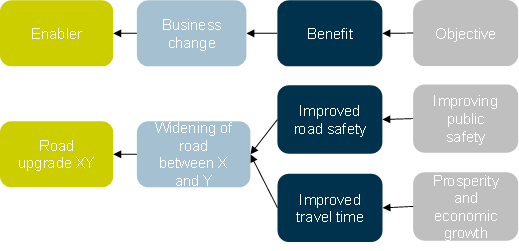2. Benefits identification
Benefits identification is an initial activity that is common to both appraisal and benefits management. It seeks to identify and define potential benefits arising from addressing an identified problem (which in turn is preventing transport system objectives and targets from being achieved). The role of benefits identification is to create a culture of accountability and transparency with benefits achievement at the forefront.
A benefit is a measurable improvement in an outcome, perceived as positive by stakeholders, and contributes towards one or more transport system objective.
Benefits identification should commence early in the ATAP Framework. In Step 2 of the Framework, benefits can be explored through techniques such as investment logic mapping, benefit dependency mapping, desk-top investigations and stakeholder management. These processes can provide an initial 'line of sight' between a problem, the strategic rationale for addressing the problem, the associated benefits and the related transport system objectives (set in Step 1 of the Framework). In Step 3, benefits identification can be further refined.
Key questions to assist in benefits identification are:
- What is the problem and related transport system objectives driving the need for a potential initiative?
- What are the outcomes being sought and expected from an initiative?
- Who are the beneficiaries?
- When are the benefits obtained?
- What are appropriate measures to define outcomes/benefits?
The result is that benefits are identified as part of early assessment and documentation, leading to a list of benefits to be fully modelled for appraisal.
Table 3 below demonstrates potential benefits mapped against objectives (assumed to have been generated as part of Step 1 of the ATAP Framework).
| Objectives | Benefits |
|---|---|
|
Prosperity and economic growth |
Improve travel time |
|
Public safety |
Improve road safety |
In identifying the benefits, the following principles should be considered:
- Capture all relevant benefits that may be used in Step 3 of the ATAP Framework (Options Generation and Assessment, see F3)
- Comprehensive identification of benefits, including benefits which cannot be monetised
- Practitioners should be made aware of the list of benefits and should take ownership of these outcomes.
2.1 Timing
Benefits identification occurs from Step 2 of the ATAP Framework (Problem Identification, Assessment and Priority, see F2) and provides key input to the appraisal process undertaken as Step 3 (Options Generation and Assessment, see F3) to identify a preferred option, and in benefits planning.
2.2 Mapping techniques to assist benefits identification
Mapping techniques such as investment logic mapping or benefit dependency mapping can be useful at this stage in the process to identify benefits. It is suggested that these techniques are undertaken in a workshop environment with the participation of key stakeholders, including a sponsor.
2.2.1 Investment logic mapping
An Investment Logic Map (ILM) is a one-page diagrammatic representation of the underlying rationale behind an initiative. The ILM focuses on the problems or issues that an initiative will try to address, the most effective responses and solutions to those problems, and measurable benefits achieved if the solution is successful.
The purpose of an Investment Logic Map is to clearly and honestly communicate the case for an initiative. The ILM links the problem/need for an initiative to the strategic objectives of the relevant jurisdiction. The ILM can consist of three columns (Problem-Benefit-Strategic objective) or five columns (Problem-Benefit-Strategic objective-Changes-Assets).[1]
Figure 2: Example of Investment Logic Map (ILM)
2.2.2 Benefits dependency mapping
It is important that benefits reflect the strategic direction of the relevant jurisdiction. A benefits dependency map can be used to identify benefits that fulfil particular objectives of the jurisdiction, and allow the expected outcomes of an initiative to be defined with stakeholders. This involves diagrammatically linking strategic objectives with expected benefits, and the enabling initiative that achieves these outcomes.
Using Figure 3 below as an example, an ex-ante approach to developing a benefits dependency map begins from right to left. First the objectives are outlined, followed by the proposed benefits that will arise from an initiative (aimed at solving a problem); then the anticipated change that will occur from the initiative is described; and finally, the supporting enablers are identified as specific outputs/solutions to be delivered. This provides a diagrammatic rationale for an initiative. Note that the benefits dependency map in Figure 3 does not reflect the ATAP Guidelines terminology and is used here for illustrative purposes to draw out the link between transport system objectives and benefits.
An ex-post view of reading the map from left to right demonstrates the progression from delivering the initiative, realisation of benefits and the achievement of stated objectives.
Figure 3: Example of benefit dependency map
[1] See VicRoads (2015), Benefits Management Framework and Department for Transport UK (2010), Logic mapping hints and tips for additional guidance on ILMs


